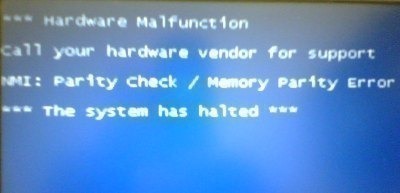NMI Parity Check/Memory Parity Error
Windows Operating System (OS) users may encounter the NMI Parity Check/Memory Parity Error during the computer start-up process. The error is normally displayed when a computer hangs or stops responding during the Windows start-up process, and may be the result of a number of hardware or hardware configuration problems.
What does the NMI Parity Check/Memory Parity Error Look Like?
A number of error codes can be displayed when the error occurs. These include:
NMI: Parity Check/Memory Parity Error, NMI: Bus Timeout, NMI: Software NMI generated, NMI: Eisa IOCHKERR board x, NMI: Channel Check/IOCHK, or NMI: Fail-safe timer
The error codes typically start with the “*** Hardware Malfunction” message and a display message indicating that the computer or system has been “halted” follows.
Why does the NMI Parity Check/Memory Parity Error Occur?
The NMI Parity Check/Memory Parity error typically occurs if a computer hardware component is damaged, malfunctions, or if an incompatible driver is installed on the computer.
How to Fix the NMI Parity Check/Memory Parity Error
Most hardware problems that trigger this error involve the computer’s RAM, motherboard, cache memory, or a hardware adapter on the computer. The following are troubleshooting steps that can be taken to identify the cause of the error:
Verify Your Computer’s Memory
Step 1 – Remove any new RAM modules that have been installed on the computer.
Step 2 – Restart the computer to see if the error message continues to be displayed.
Step 3 – If the error is eliminated, then replace the RAM modules that were installed. If it persists, repeat the process but only leave the minimum amount of RAM necessary to boot the computer in order to determine if the computer has faulty RAM.
Step 4 – Replace the faulty RAM modules if they are the source of the problem.
The Microsoft RAM diagnostic tool found at: http://oca.microsoft.com/en/windiag.asp may also be used in order to help identify faulty computer modules.
Verify the Adapters on the Computer
Step 1 – Remove all adapters that are not required to run or start the computer. Most Windows computers can be run with only the video and drive subsystem controller adapters.
Step 2 – Restart the computer. If the error does not appear, then the problem is one of the adapters removed in step 1.
Step 3 – Reinstall one adapter at a time until the error is displayed again. This determines the adapter that was the source of the error. Visit the adapter manufacturer’s website and download and install the latest version.
Step 4 – Re-seat all adapter hardware cards if the error is not eliminated to ensure that this is not the cause of the problem.
Verify the Computer BIOS
Step 1 – Ensure that the latest revision of the computer’s BIOS and firmware configuration are installed.
Step 2 – Open the BIOS and change the configuration to “load Fail-safe defaults” or “BIOS defaults,” set “Plug and Play OS” to “No,” and disable anti-virus protection options located in the BIOS.
Step 3 – Restart the computer to see if the error has been corrected.
Check for Driver Updates
If Windows OS was recently upgraded or new hardware installed, then an outdated device driver may be the cause of the error.
Step 1 – Ensure that Windows Updates is configured to automatically update the computer from the “Windows Updates” application found in the computer’s “Control Panel.” Manually update the Operating System. Restart the computer after completing the manual Windows update.
Step 2 – If any new hardware was installed, remove the hardware drivers in the “Add/Remove Programs” menu after updating the OS in Step 1 and restart the computer.
Step 3 – Check the other device drivers installed on the computer for updates if the error is still being displayed and an update as required. Restart the computer after each device driver update to complete troubleshooting it.


Comments - 2 Responses to “NMI Parity Check/Memory Parity Error”
Sorry but comments are closed at this time.